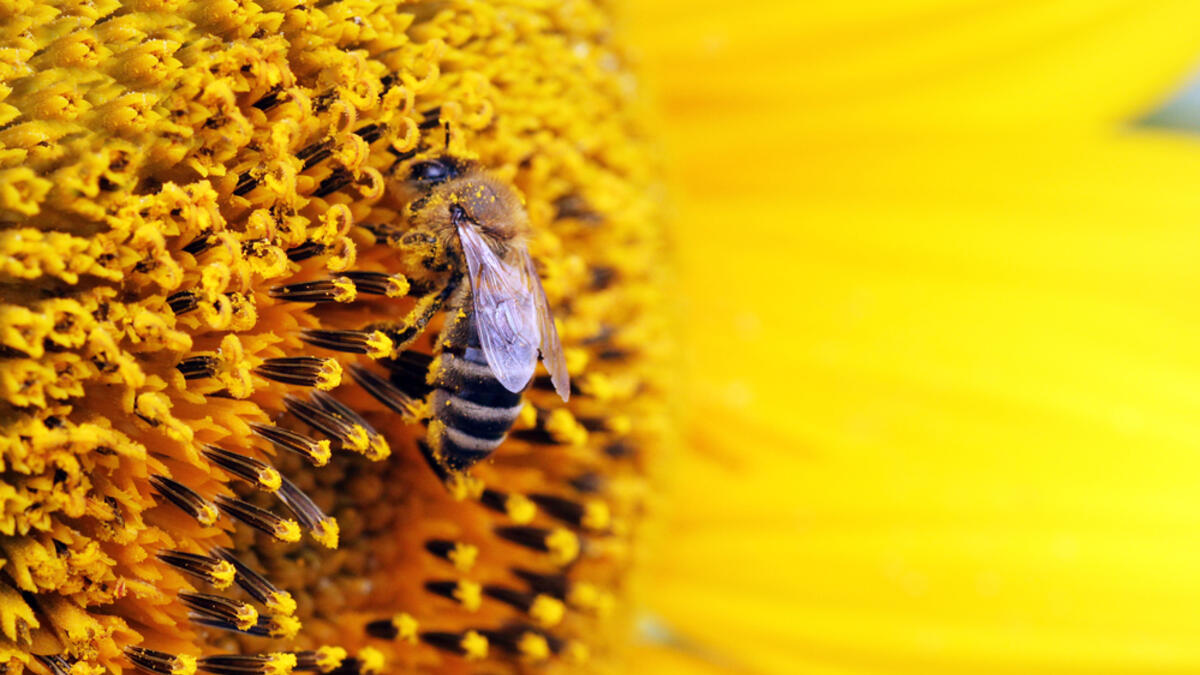Pollen: A crime-solving tool?

A bee collects pollen from a sunflower. Photo courtesy of depositphotos.com.
Pollen is widely known both as an incredibly important aspect of creating our ecosystems and as an annoyance to those who suffer from allergies.
It can easily transfer to your hands or clothing when you pick a flower. This transferability is among several reasons why pollen is being investigated for forensic tracking and may be a key element in helping to determine place of origin and movement in a variety of circumstances, including the investigation of criminal activity.
Forensic palynology, which is the act of using pollen to link persons and objects to specific locations, isn’t a new method of forensic investigation. It has been used in a variety of ways, including being used to link the movement of bodies in mass graves in Bosnia. But researchers are now working to leverage the power of geocomputation, geographic information science and spatial optimization modeling to improve upon existing approaches. Supported through a multimillion dollar MURI award from the Department of Defense, researchers have released with their article “Indentifying the spatial footprint of pollen distributions using the Geoforensic Interdiction (GOFIND) model” in the journal Computers, Environment and Urban Systems.
“Pollen grains are small and can nestle, undetected, into clothing, backpacks, shoes and almost any object, including the human body, like under fingernails or on human hair,” said Daoqin Tong, associate professor in ASU’s School of Geographical Sciences and Urban Planning and lead author on the paper. “Also, pollen is durable and ubiquitous in the environment and is highly resistant to chemical weathering and can exist without decay for years or even decades.”
These characteristics of pollen make forensic palynology a novel way to help track point of origin or movement of items that have been used in criminal and terrorist activities, such as computers, undetonated explosives and paper. In the past, this method has been rarely used in practice due to barriers such as a slow process to identify microscopic pollen samples and no current tools to map pollen to specific geolocations. It’s this location information that researchers are hoping to tackle with their GOFIND model.
GOFIND is a mathematical model that helps identify forensic samples’ geographic origin by using the geospatial signatures attached to plant species and where they can be found. The model is structured to account for the complexities of different forensic samples and their potential multi-geographic origins. For instance, the Saguaro cactus blooms from mid-April to early June and there is only one region on Earth where this happens. The GOFIND model research team is working to ultimately combine this spatial and temporal information of different pollen samples to better assist in using pollen for forensic investigations.
“This is an exciting advance for the field of forensic palynology,” said Micheline Strand, program manager for this MURI grant from the U.S. Army Combat Capabilities Development Command, known as DEVCOM, Army Research Laboratory. “Forensic palynology is an important tool for countering terrorism, smuggling and counterfeit goods.”
As they continue the work in this field, the researchers will continue to grow their catalog of pollen samples to include in their GOFIND model.
“This work is part of a much larger project that will use pollen samples collected from around the United States and the world to fine-tune the GOFIND model,” said Tony Grubesic, professor at the University of Texas at Austin and co-author of the article.
They plan to not only collect more pollen samples to include in the GOFIND model, but also will work to help mitigate some of the model’s current weaknesses.
“GOFIND does not account for the more complex factors associated with pollen movement, especially given human interactions with pollen,” Tong said. “We plan to construct a second model to account for these spatial interactions and the many human factors that can potentially mediate the movement of pollen in geographic space.”
More Science and technology

ASU postdoctoral researcher leads initiative to support graduate student mental health
Olivia Davis had firsthand experience with anxiety and OCD before she entered grad school. Then, during the pandemic and as a…

ASU graduate student researching interplay between family dynamics, ADHD
The symptoms of attention deficit hyperactivity disorder (ADHD) — which include daydreaming, making careless mistakes or taking…

Will this antibiotic work? ASU scientists develop rapid bacterial tests
Bacteria multiply at an astonishing rate, sometimes doubling in number in under four minutes. Imagine a doctor faced with a…